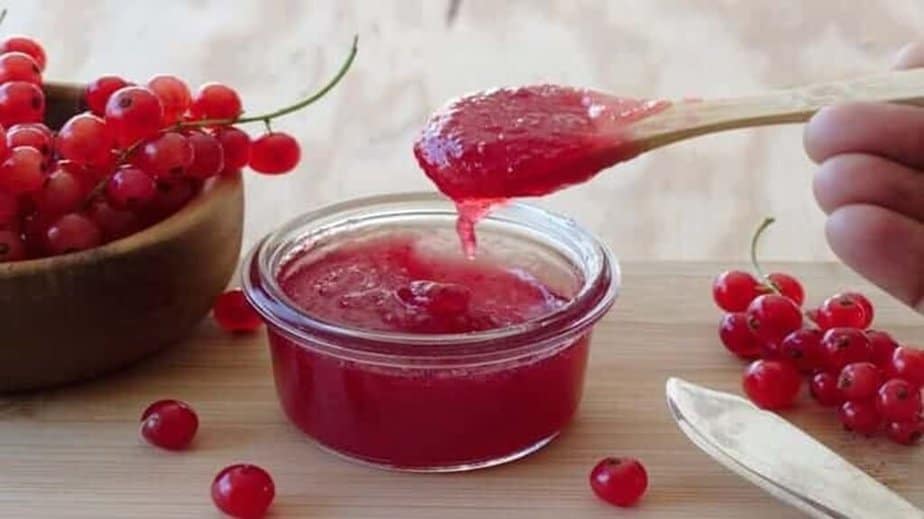What Is Red Currant Jelly?
Red currant jelly, also known as redcurrant sauces, is an English condiment made of red currants, sugar, and water. There are several versions of this jelly with a few additional ingredients such as white wine, red wine, mustard, rosemary, port, orange/lemon zest, or shallots. Basically, it’s a jelly or sauce made of red currant berries.
The red currant or redcurrant (Ribes rubrum) is a member of the genus Ribes in the gooseberry family. The redcurrant plant is native to northern and eastern Europe and was first cultivated and included in culinary uses in Belgium and northern France in the 17th century.
In the UK, the red currant sauce is traditionally eaten as part of a Sunday roast, particularly with roast lamb, roast turkey, or roast goose, and an integral part of festive meat dishes.
Red currant sauce is similar but simpler than Oxford and Cumberland sauces that have port added to their constituents. The production of this jelly is rampant in summer when the freshly ripened currant berries are harvested.
Red currant jelly tastes sweet and tart making it a scrumptious topping on many dishes. When not made into jelly, these berries are often used as toppings on cakes and puddings. They can also be eaten raw or used in cocktails and fruity salads like raspberries and rhubarb.
How Is It Made?
Generally, a fruit jelly is made by cooking the extracted fruit juice with sugar and pectin. However, for making red currant jelly you don’t need to use store-bought pectin because the currants naturally have a perfect combination of acidity and pectin. On heating, the pulp of the currants forms a good gel-like texture without using any additional stabilizer agents. The boiled pulp of red currant berries quickly turns into a jelly with the bright red color of the fruit.
Red Currant Jelly Recipe
Ingredients
- 2 pounds ripe red currants
- 1/2 cup water
- 2 1/2 cups sugar
Instructions for Making
Wash the currants and remove the stems and seeds from them.
Place the currants in the nonreactive pot (for this berry contains acid) and add water.
Cook, stirring, over medium heat for about 20 minutes till the red currants have released all their juice; while cooking crush the fruits with a potato smasher or jam skimmer for pressing out maximum juice.
Drain the cooked currants into the bowl by pouring out the liquid in a dampened jelly bag or several layers of cheesecloth covering the mouth of the bowl; let the liquid gradually ooze out into the bowl for a few hours or overnight but don’t squeeze the fruit slurry.
After straining, transfer the red currant juice into a nonreactive pot and add sugar equal to the measure of the juice.
Boil the mixture of juice and sugar over high heat, stirring constantly to dissolve the sugar. Continue cooking the mixture until it reaches the gel point.
Transfer the simmering jelly into a sterilized jar leaving ½ inch headspace and close it with the lid. Once cooled, the jelly is ready to be used.
Culinary Uses
Currants can be eaten raw or cooked, but more often cooked in jelly, pie, or jam. This jelly is a delicious serve alongside game meats, especially venison. It is an excellent accompaniment to roasted meat, sausages, and oily fish. Serve it with cheese, cold meats, or pork pie, or spread a little jelly on the top of slices of crusty bread, on slices of goat’s cheese, or grill for a quick starter or lunch. A tablespoon of this jelly added to Sunday gravy or caramelized onions can simply make them delicious. The list does not end here but you can try it on anything to add a tangy-sweet flavor.
Related: Elderflower Culinary Uses And Substitutes
Benefits Red Currants
Currants are a rich source of vitamin C and help to fight anemia. Powerful antioxidants in this berry are effective for cardiovascular diseases and premature cell aging. A ripened red currant contains a good bit of flavonoid and vitamin B that helps to fortify the capillaries and prevent arteriosclerosis, apoplexy, and diabetes.
Red currants are rich in vitamin K strengthen the bones and reduce the urinary excretion of calcium. Studies suggest that redcurrant fruit is antiscorbutic, diuretic, laxative, depurative, digestive, aperient, refrigerant, and sialagogue. Consuming a concoction of currants may help to relieve rheumatic symptoms. This berry is also used in poultices to relieve sprains or reduce the pain of dislocations.
Final Thoughts
In summary, red currant jelly, an English condiment made from red currants, sugar, and water, is versatile and can include additional ingredients like wine or herbs.
Originating from northern Europe, it’s a traditional accompaniment to roasted meats in the UK. This sweet-tart jelly is made using the natural pectin and acidity of red currants, offering culinary versatility in various dishes from game meats to desserts.
Additionally, red currants are nutritious, and rich in vitamins and antioxidants, offering health benefits like improved cardiovascular health and bone strength.
Read Next: Benefits Of Elderflower
